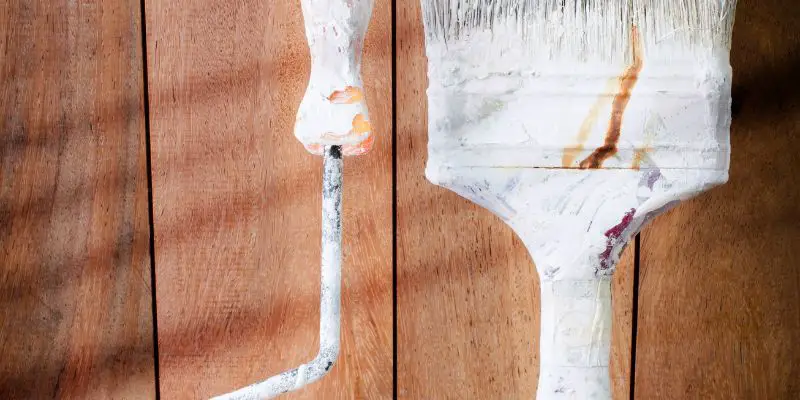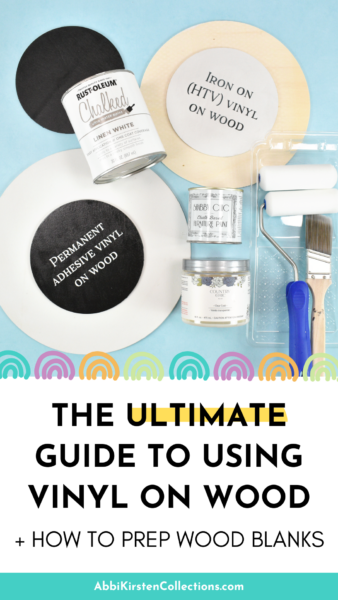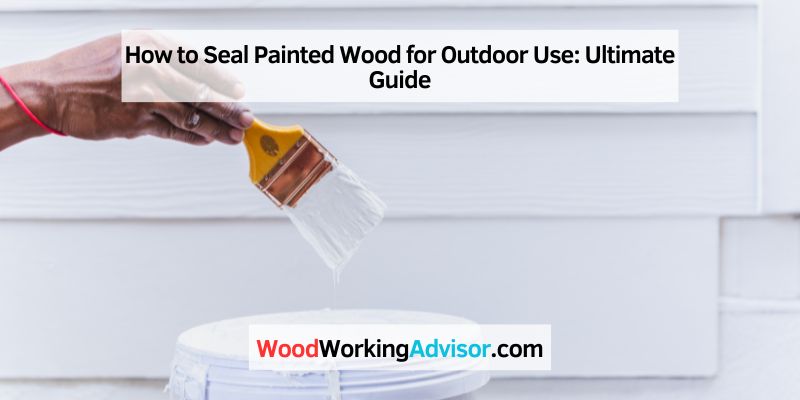To seal painted wood for outdoor use, apply a weatherproofing varnish or outdoor sealant.
Choosing The Right Sealant
To ensure the outdoor durability of painted wood, selecting the right sealant is crucial. Look for a sealant specifically formulated for outdoor use, designed to protect against moisture, UV rays, and extreme weather conditions. Applying a high-quality sealant will help maintain the appearance and integrity of the painted wood for an extended period.
To ensure long-lasting protection for your painted wood project that will withstand outdoor elements, choosing the right sealant is crucial. With so many options available, it can be overwhelming to make the right choice. In this section, we will discuss two important factors to consider when selecting a sealant: whether to go for oil-based or water-based and the importance of UV-resistant sealants.
Oil-based Vs. Water-based Sealants
When it comes to sealants for painted wood, you have the choice between oil-based and water-based options. Both offer their own set of advantages and considerations, so let’s take a closer look:
Oil-based Sealants: These sealants are known for their durability and provide excellent protection against moisture. They are ideal for exterior wood projects, such as outdoor furniture or decks, as they penetrate deep into the wood, creating a strong barrier against water and preventing rotting or warping. Oil-based sealants also tend to enhance the natural beauty of the wood, bringing out its rich tones.
Water-based Sealants: If you prefer a sealant that is easier to work with and has a quicker drying time, water-based sealants are a great option. They are also more environmentally friendly and have low levels of VOCs (volatile organic compounds), making them a safer choice for both you and the environment. Water-based sealants offer good UV resistance and protect against mildew and mold growth, making them suitable for a wide range of outdoor wood projects.
Uv-resistant Sealants
When selecting a sealant for outdoor use, it is crucial to consider its UV resistance. Constant exposure to sunlight can cause painted wood to fade and deteriorate over time. UV-resistant sealants act as a protective shield, preventing the harmful effects of the sun’s ultraviolet rays, such as color fading and wood degradation. Look for sealants specifically formulated to withstand UV rays to ensure your painted wood maintains its vibrant look and extends its lifespan.
In conclusion, choosing the right sealant for your painted wood project is essential for long-term durability. Assess the specific needs of your project, whether it requires oil-based or water-based sealants, and prioritize UV-resistant options to protect against sun damage. By selecting the right sealant, you can ensure that your outdoor wood projects remain beautiful and protected for years to come.

Preparing The Wood Surface
The key to ensuring your painted wood withstands the elements is proper preparation. Before sealing the painted wood for outdoor use, it’s essential to follow a few crucial steps to ensure a long-lasting finish. This section will guide you through sanding and cleaning the wood surface, as well as priming it for optimal results.
Sanding And Cleaning
1. Sand the Surface: Start by sanding the painted wood surface to create a smooth and even finish. Using a sandpaper or sanding block with medium grit, apply gentle pressure and move in the direction of the wood grain. This step helps remove any rough spots, paint drips, or imperfections.
2. Clean Thoroughly: Once the sanding is complete, it’s crucial to remove any dust, dirt, or debris from the surface. A clean surface ensures proper adhesion of the sealant. Use a soft brush or cloth to sweep away loose particles, and then wipe the surface with a damp cloth to remove any remaining residue.
Priming The Surface
1. Choose the Right Primer: Applying a high-quality primer serves as an important step in sealing painted wood for outdoor use. Look for a primer specifically designed for exterior applications, such as a paint and primer in one formula. This will help enhance the color, durability, and overall longevity of the final finish.
2. Apply an Even Coat: Once you’ve selected the appropriate primer, follow the manufacturer’s instructions to apply an even coat over the entire wood surface. Use a brush or roller, moving in the direction of the wood grain. Apply the primer evenly, avoiding any thick or uneven spots, as this may impact the final result.
3. Allow Sufficient Drying Time: After priming, give the wood ample time to dry completely. Follow the recommended drying time specified on the primer container. This waiting period ensures that the primer adheres properly and provides a solid foundation for the subsequent sealing process.
By following these steps to prepare the wood surface before sealing, you are laying the groundwork for a durable and weather-resistant painted finish. Taking the time to sand, clean, and prime your painted wood will result in an outdoor project that stands the test of time.
Applying The Sealant
Applying the sealant is a crucial step in ensuring that your painted wood can withstand outdoor conditions. It helps to protect the wood from moisture, UV rays, and other elements that can cause damage over time.
Brushing Vs. Spraying
When it comes to applying sealant to painted wood, you have the option of brushing or spraying the sealant onto the surface. Both methods have their advantages.
- Brushing:
Requires less equipment and can be more precise in getting the sealant into the grooves and crevices of the wood.
- Spraying:
Is faster and can provide more even coverage, especially for large surfaces.
Number Of Coats
When applying the sealant, it is important to consider the number of coats needed to adequately protect the wood. In most cases, two coats of sealant are recommended for best results.
Drying And Curing
To ensure that painted wood stays protected from outdoor elements, it’s crucial to properly dry and cure the paint. This involves allowing sufficient time for the paint to dry completely before applying a sealant for added protection against moisture and UV rays.
Optimal Drying Conditions
To ensure a successful seal on your painted wood for outdoor use, it is crucial to pay attention to the drying process. Proper drying conditions can make all the difference in the durability and longevity of your finished project. Here are some key factors to consider:
- Adequate Ventilation: Place the painted wood in a well-ventilated area to allow for proper air circulation. This will help the paint dry evenly and prevent any moisture from getting trapped.
- Temperature: It’s important to choose the optimal temperature range for drying. Ideally, the temperature should be between 50-90°F (10-32°C). Extreme temperatures can affect the drying process, so avoid placing the painted wood in direct sunlight or in extremely cold or humid environments.
- Relative Humidity: Maintain a relative humidity level between 40-70%. Higher humidity levels can lead to slower drying times and may cause the paint to become sticky or tacky. Lower humidity levels can result in faster drying, but they may also cause the wood to dry out too quickly, leading to cracking or warping.
Curing Time
After the paint has dried, the next step is allowing sufficient time for curing. Curing is the process of the paint fully hardening and reaching its maximum durability. Here’s what you need to know:
- Manufacturer’s Recommendation: Check the paint manufacturer’s instructions for the recommended curing time. Different types of paint may have specific curing requirements, so it’s essential to follow their guidelines.
- Initial Drying vs. Full Cure: While the paint may feel dry to the touch after a few hours, it’s important to note that it’s not fully cured at this stage. Depending on the type of paint, the curing process can take anywhere from a few days to several weeks. Be patient and allow enough time for the paint to cure completely before exposing it to harsh outdoor conditions.
- Protective Measures: Until the paint has fully cured, avoid placing objects on the painted surface or subjecting it to significant stress. Take precautions to protect the painted wood from any potential damage during the curing process.
By following optimal drying conditions and allowing the necessary curing time, you can ensure that your painted wood is well-prepared for outdoor use. Taking these extra steps will help protect your project from the elements and maintain its beauty for years to come.
Maintenance And Reapplication
To seal painted wood for outdoor use, proper maintenance and reapplication are crucial. Regularly inspect the surface for signs of wear and tear, and reapply a weather-resistant sealant to protect it from the elements. This ensures the longevity of the painted wood and maintains its vibrant appearance.
Regular Inspection
Regular inspection is crucial to maintain the integrity of the painted wood and ensure its durability in outdoor settings. By conducting routine inspections, you can identify any signs of wear and tear, as well as potential issues that may require immediate attention. It is advisable to inspect the painted wood at least once every few months, or more frequently if you live in an area with harsh weather conditions.
Reapplication Schedule
Having a reapplication schedule in place will help you keep your painted wood looking fresh and protected from the elements. The frequency of reapplication will depend on factors such as the type of paint used, the level of exposure to sunlight and moisture, and the overall condition of the painted surface. As a general rule of thumb, it is recommended to reapply a protective sealant every 1 to 3 years.
| Type of Paint | Exposure to Sunlight and Moisture | Recommended Reapplication Frequency |
|---|---|---|
| Oil-based Paint | High | 1-2 years |
| Latex Paint | High | 2-3 years |
| Oil-based Paint | Moderate | 2-3 years |
| Latex Paint | Moderate | 3-4 years |
| Oil-based Paint | Low | 3-4 years |
| Latex Paint | Low | 4-5 years |
Ensuring Proper Reapplication
When it comes to reapplying a sealant to painted wood, it is important to follow the manufacturer’s instructions and guidelines. Here are some steps to ensure proper reapplication:
- Clean the painted wood surface thoroughly by removing any dirt, dust, or debris.
- Sand the surface lightly to create a smooth and even texture.
- Apply the sealant using a brush or roller, following the grain of the wood.
- Allow the sealant to dry completely before applying a second coat if necessary.
- Regularly inspect the painted wood after reapplication to check for any signs of damage or wear.
By maintaining a regular inspection schedule and following the recommended reapplication frequency, you can ensure that your painted wood remains protected and visually appealing in outdoor environments. Remember to choose the appropriate sealant for your specific type of paint and geographic location to ensure optimal results and a long-lasting finish.

Credit: www.abbikirstencollections.com
Frequently Asked Questions On How To Seal Painted Wood For Outdoor Use
What Is The Best Sealer For Outdoor Painted Wood?
The best sealer for outdoor painted wood is a clear waterproof sealant. It provides protection from water damage and UV rays, extending the life of the paint. Look for a product specifically designed for outdoor use to ensure long-lasting results.
Can You Weatherproof Painted Wood?
Yes, you can weatherproof painted wood to protect it from the elements. Applying a weatherproof sealant or finish can help prevent water damage and extend the life of the paint. Make sure to clean and prepare the surface before applying the weatherproofing product.
What Can I Put Over Paint To Make It Waterproof?
To make paint waterproof, you can apply a clear waterproof sealant or use a waterproofing additive.
How Do You Seal Interior Paint For Outdoor Use?
To seal interior paint for outdoor use, apply a weather-resistant sealant over the dried paint. Ensure proper ventilation and allow the sealant to cure completely. Regular maintenance and reapplication may be necessary to protect the paint from outdoor elements.
Conclusion
Ensuring the longevity of outdoor painted wood is crucial for its durability and visual appeal. By following the steps outlined in this guide, you can effectively seal painted wood for outdoor use and protect it from the elements. With the right products and techniques, your outdoor painted wood will withstand the test of time and enhance the beauty of your space for years to come.



2 thoughts on “How to Seal Painted Wood for Outdoor Use: Ultimate Guide”